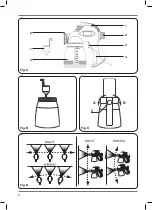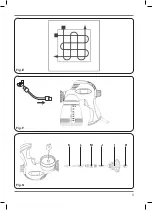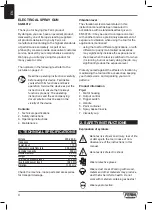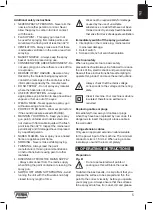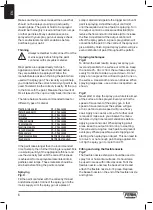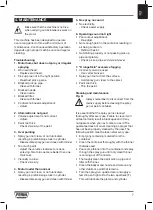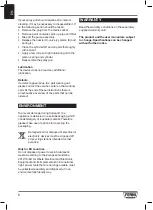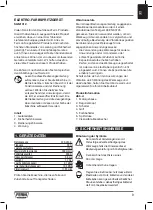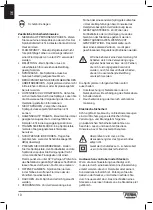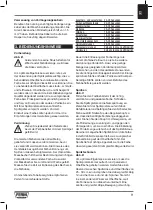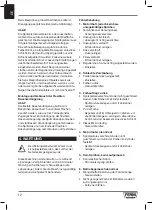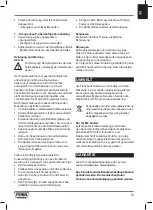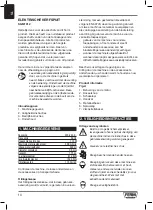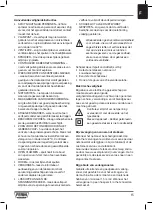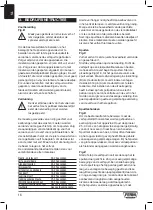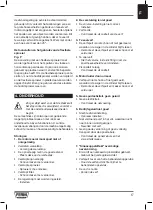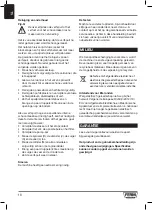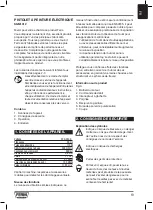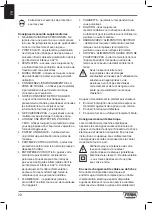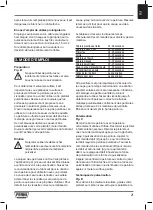
6
EN
Make sure that you have masked the areas that
should not be sprayed, using a good quality
masking tape. The paint or fluid to be sprayed
should be thoroughly mixed and free from lumps
or other particles. Many substances can be
sprayed with your spray gun, but always check
the manufacturers recommendations before
purchasing your paint.
Thinning
Always remember to disconnect from the
mains supply before filling the paint
container with sprayable material.
Most paints are supplied ready for brush
application and will need to be thinned before
they are suitable to be sprayed. Follow the
manufacturers advice on thinning the paint when
used with a spray gun. The viscosity cup will help
you to determine the correct viscosity of paint to be
used. To determine the correct viscosity, fill the cup
to the brim with the paint. Measure the amount of
time it takes for the cup to empty back into the can.
The table below shows recommended times for
different types of material.
Plastic & latex paint
24 - 28 seconds
Water based paint
20 - 25 seconds
Primers
24 - 28 seconds
Varnishes
20 - 25 seconds
Oil based paints
18 - 22 seconds
Enamel paints
18 - 22 seconds
Aluminium paints
22 - 25 seconds
Car undersealing
25 - 35 seconds
Wood sealers
28 - 35 seconds
Wood preservatives
No thinning required
Wood stains
No thinning required
If the paint takes longer than the recommended
time to empty, then further thinning is required. Mix
in a small quantity of the appropriate thinner and
use the viscosity test until the correct thickness
is achieved. Some sprayable materials contain
particles and lumps. These materials should be
strained before filling the paint container.
Spraying
Fig. C
Fill the paint container with the correctly thinned
and strained paint. Connect the spray gun to the
mains supply. Aim the spray gun at a piece of
scrap material and operate the trigger switch until
paint is spraying. Adjust the output control (2)
until the required volume of paint is spraying. Turn
the output control in a clockwise direction (B) to
reduce the flow and anti-clockwise (A) to increase
the flow. Adjustment of the output control will
affect the spray pattern. A poor spray pattern will
concentrate the paint in the centre of the spray and
give a blotchy finish. A good spray pattern will give
even distribution of paint throughout the pattern.
Spraying techniques
Fig. D
To obtain the best results, keep your spray gun
level and parallel to the surface at all times. Keep
the nozzle 25 - 30 cm from the surface and spray
evenly from side to side or up and down. Do not
spray at an angle as this will lead to paint runs on
the surface. Use smooth and even strokes. When
spraying large areas, use a criss-cross pattern as
shown.
Fig. E
Never start or stop the spray gun while it is aimed
at the surface to be sprayed. Evenly control the
speed of movement of the spray gun. A fast
speed of movement over the surface will give
a thin coat and a slow speed will give a heavy
coat. Apply one coat at a time. If a further coat
is required, make sure you observe the manu-
facturers drying time recommendations before
applying a second coat. When spraying small
areas, keep the output control on a low setting.
This will avoid using too much paint and prevent
overspray. Where possible, avoid stopping and
starting when spraying an object. This can lead to
too much, or not enough paint being applied. Do
not tip the spray gun to more than 45°.
Fitting and using the flexible nozzle
Fig. F
The flexible nozzle extension should be used to
spray flat or horizontal surfaces. It should also
be used in areas with limited access. To fit the
flexible nozzle, unscrew the basket nozzle and
attach the flexible nozzle in it‘s place. Replace
the basket nozzle on the end of the flexible nozzle
and tighten.
Summary of Contents for SGM1012
Page 2: ...B A 2 2 Fig B Fig C Fig A Fig D 1 2 3 4 5 7 6...
Page 3: ...3 Fig E Fig F Fig G K L M J I H...
Page 104: ...104 RU O EN 60745 A 1 2 3 4 5 6 7 2 O O O O O O 32 C...
Page 105: ...105 RU 85 A 32 C o y 1 5 2 3 B...
Page 106: ...106 RU 24 28 20 25 24 28 20 25 18 22 18 22 22 25 25 35 28 35 C 2 D 25 30 E...
Page 107: ...107 RU 45 F 4 O 1 2 3 4 5 6 7...
Page 108: ...108 RU G F H J K L M 2012 19 EU...
Page 114: ...114 EL 2012 19 EU...
Page 115: ...115...
Page 116: ...116...
Page 118: ...118 Exploded view...
Page 120: ...WWW FERM COM 2021 FERM 2103 11...


